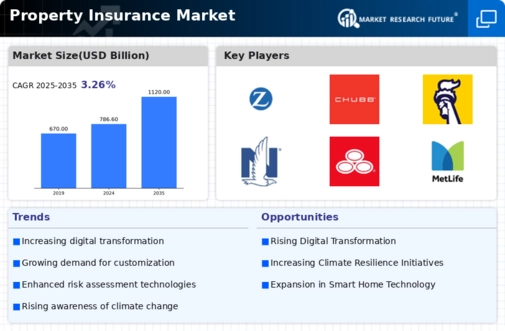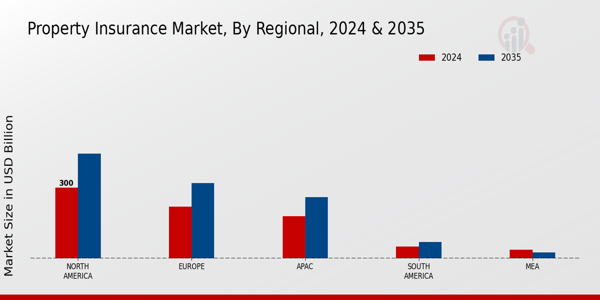Market Growth Projections
The Global Property Insurance Market Industry is projected to experience substantial growth over the next decade. With a current valuation of 786.6 USD Billion in 2024, the market is expected to reach 1120 USD Billion by 2035. This growth trajectory suggests a compound annual growth rate of 3.26% from 2025 to 2035. Factors contributing to this expansion include increasing natural disasters, urbanization, technological advancements, and heightened risk awareness among property owners. The market's evolution reflects the dynamic nature of the insurance landscape, where adaptability and innovation are crucial for meeting the changing needs of policyholders.
Increasing Natural Disasters
The frequency and severity of natural disasters, such as hurricanes, floods, and wildfires, are rising globally, which drives the demand for property insurance. In 2024, the Global Property Insurance Market Industry is valued at approximately 786.6 USD Billion, reflecting the urgency for homeowners and businesses to protect their assets. Insurers are adapting their policies to cover these risks, leading to an increase in premiums. As climate change continues to exacerbate these events, the market is expected to grow further, with projections indicating a value of 1120 USD Billion by 2035. This trend highlights the critical role of property insurance in risk management.
Regulatory Changes and Compliance
Regulatory changes and compliance requirements are significant drivers of the Global Property Insurance Market Industry. Governments worldwide are implementing stricter building codes and safety regulations to mitigate risks associated with property damage. These regulations compel property owners to secure adequate insurance coverage, thereby increasing market demand. In 2024, the market's valuation of 786.6 USD Billion reflects the impact of these regulatory frameworks. Insurers must adapt their offerings to meet compliance standards, which can lead to increased premiums but also enhanced protection for policyholders. This evolving regulatory landscape is likely to sustain growth in the market, contributing to a projected value of 1120 USD Billion by 2035.
Rising Awareness of Risk Management
There is a growing awareness of risk management among property owners, which is driving the Global Property Insurance Market Industry. As individuals and businesses recognize the potential financial impacts of property damage, they are increasingly seeking insurance solutions to safeguard their investments. This heightened awareness is reflected in the market's valuation of 786.6 USD Billion in 2024. Educational initiatives and marketing campaigns by insurers are further promoting the importance of property insurance. As this trend continues, it is anticipated that the market will experience a compound annual growth rate of 3.26% from 2025 to 2035, ultimately reaching a value of 1120 USD Billion by 2035.
Technological Advancements in Insurance
Technological advancements are reshaping the Global Property Insurance Market Industry by enhancing risk assessment and claims processing. Insurers are increasingly utilizing artificial intelligence, big data analytics, and the Internet of Things to improve underwriting accuracy and customer service. These innovations allow for more personalized insurance products, catering to the specific needs of policyholders. In 2024, the market is valued at 786.6 USD Billion, with technology playing a pivotal role in driving efficiency and reducing operational costs. As the industry embraces digital transformation, it is expected to attract a broader customer base, contributing to the projected market growth to 1120 USD Billion by 2035.
Urbanization and Infrastructure Development
Rapid urbanization and infrastructure development are significant contributors to the growth of the Global Property Insurance Market Industry. As populations migrate to urban areas, the demand for residential and commercial properties increases, necessitating comprehensive insurance coverage. In 2024, the market's valuation of 786.6 USD Billion reflects this trend, as urban centers require robust insurance solutions to protect against various risks. Furthermore, the ongoing development of infrastructure projects enhances the need for specialized insurance products, particularly in emerging economies. This urban-centric growth is likely to sustain a compound annual growth rate of 3.26% from 2025 to 2035, further expanding the market.





















